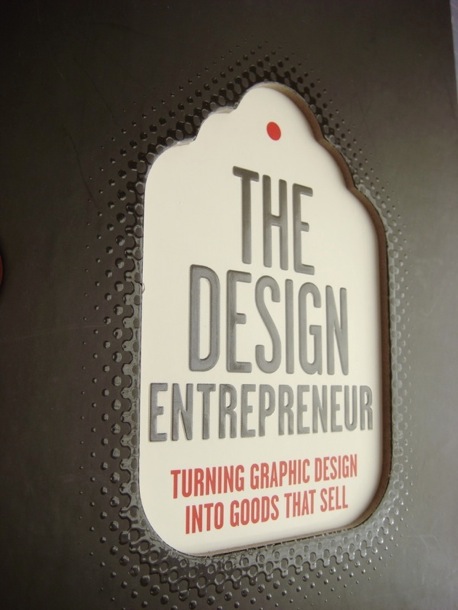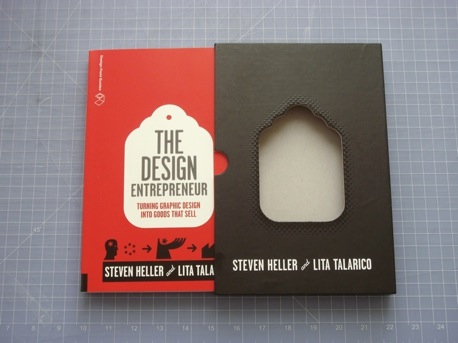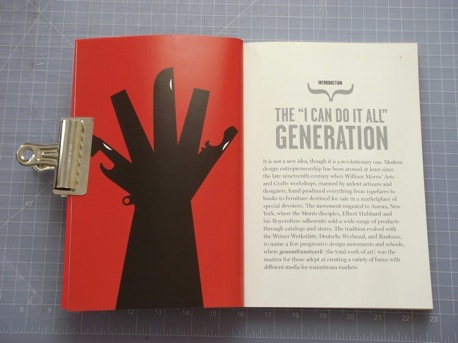The Design Entrepreneur: Turning Graphic Design into Goods that Sell

Guest review by Colin Ford
Clients blow.
Designers the world over know this to be the unfortunate truth. Clients come to you for your artistic vision and then try to drag your design back into mediocrity by insisting that 12-point Times New Roman be used for all body copy, or that their second cousin thinks chartreuse would be a better color for the packaging. With their new book, Steven Heller and Lita Talarico tell you to say to hell with clients and their second cousins – you should be designing your own products and making money while you’re at it.
(Click to enlarge)
The Design Entrepreneur (Amazon: US



Of 240 pages, Heller and Talarico write a total of 17 pages on the ‘how-tos’ of being a design entrepreneur – from coming up with entrepreneurial ideas to turning them into products. The majority of the book consists of 53 interviews with D.I.Y. designers, 14 case studies of student work from the SVA Graphic Design MFA program (of which Heller and Talarico are the co-chairs), and a selection of helpful links.
(Click to enlarge)
Overall, this book tends to be at its most interesting when Heller and Talarico are at the helm. The sections written by the authors offer invaluable advice on collaboration, idea stimulation, surveying your market, creating a business plan, promoting your product, and other topics important to business-minded designers that are otherwise hidden away in impenetrable business texts. These sections are helpfully laid out and easy to understand.
(Click to enlarge)
The only tragedy here is that there is not enough of this practical content. Topics like product distribution, on which an entire chapter could be written, are cut down to just two scant paragraphs.
To give one an idea of the useful-yet-concise style in which Heller and Talarico give advice, here is their entire section on Promotion:
Promotion
“Promotion for your product starts at the very beginning with the packaging, point of purchase displays, and anything else you can do to grab your customer’s attention and encourage them to buy your product. The objective is to get out information about your product. Determine what your objective is and then develop both a short- and long-term promotional plan to help position your product and increase sales.”
The good news is that the interviews are, for the most part, meaty. Heller and Talarico quiz the likes of Shepard Fairey, William Drenttel and Jessica Helfend, Jim Coudal, Maira Kalman, and Ellen Lupton on a variety of topics, from why they decided to quit the client-design game to more personal questions.
(Click to enlarge)
While Heller and Talarico don’t grant you access to their interviewees’ most intimate business secrets, you do learn the origins of Dave Eggers‘s successful 826 Valencia (six words: ‘taxidermy and show-animal grooming supplies) and how inky little monsters turned Stefan Bucher‘s innocent design blog into a daily Internet staple.
The Design Entrepreneur offers a lot of hope to designers who dream of a life without clients. Though comprehensive by no means, Heller and Talarico have compiled a fine book with a little bit of instruction and a lot of examples that should prove to be a valuable first step for any designer with the drive and the guts to shed their clients and be their own boss. The rest of us should pick up this book, too, if only to dream – now, what’s that Pantone number for chartreuse, again?
The Design Entrepreneur: Turning Graphic Design into Goods that Sell is published by Rockport. You can support The Designer’s Review of Books by buying it from Amazon (US



[If you were wondering, the Pantone number for chartreuse is Pantone 14-0445 and it’s web version is #7FFF00. And I love clients. Always happy to have more of them – Ed.]
About the reviewer
Colin M. Ford is an undergraduate at the Maryland Institute College of Art in Baltimore, MD, and is majoring in Graphic Design. He one of Ellen Lupton’s Design Writing Research students.





